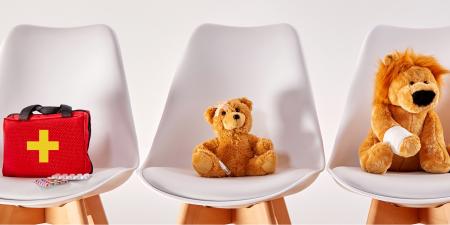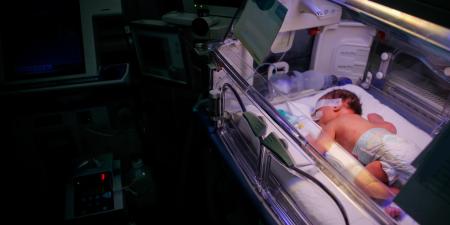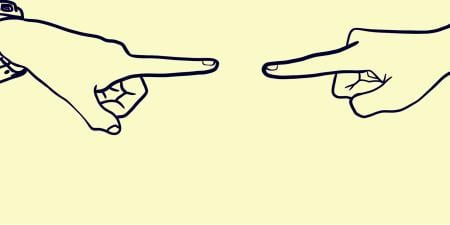Abstract
Hospitalized children who undergo painful procedures are more susceptible than others to experiencing iatrogenic effects, such as anxiety, pain, and severe stress. Clowns in clinical setting have been found to be effective in reducing children’s experiences of these effects during hospitalization and before procedures. This article provides an overview of clowning in health care settings; reviews major studies conducted on clowning for hospitalized children, discussing evidence that clown interventions decrease pain and distress in pediatric patients; and concludes with a discussion of health care clowning as a profession.
Introduction
Surgery and hospitalization are significant stressors for children that can provoke negative health effects [1]. It is estimated that up to 60 percent of children who undergo surgery experience anxiety in the holding area and during the induction of anesthesia [2]. During the preoperative period, it is likely that specific symptoms of anxiety such as worry, fear, nervousness, and tension will appear [3, 4]. Children’s greater vulnerability to the stress of surgery is due to developmental characteristics such as their limited cognitive capacity, lack of self-control, greater dependence on others, and fear of pain [5]. Moreover, children’s preoperative anxiety can have marked distressing and traumatic consequences for their families, regardless of whether they are psychologically ill prepared [6].
What can be done to mitigate children’s preoperative anxiety? Over the past 30 years, there has been a surge of interest in the use of complementary and alternative medicine (CAM) in Western industrialized nations to supplement patients’ allopathic care [7, 8]. CAM includes approaches that are not considered to be conventional medical practice in a given society over a given period of time [9]; this variety of approaches includes acupuncture, osteopathy, homeopathy, and neural therapy, all of which can be used to treat acute and chronic diseases in adults and children [10, 11]. One such CAM approach is “therapeutic clowning,” a goal of which is to providing humor-based distraction to improve hospitalized pediatric patients’ moods and reduce their anxiety.
Hospital clowning is an interdisciplinary art that involves a wide variety of skills, such as humor, drama, music, and dance, and has a notable beneficial and therapeutic impact on patients [12]. First established in the US in 1986 by professional clown Michael Christensen, therapeutic clowning has since become a popular practice in hospitals worldwide, especially with, but not limited to, children [13, 14]. The main aim is to distract patients during the preoperative period [14, 15] and during medical procedures [16], induce positive emotions, and decrease negative emotions in order to demystify medicine and help in the healing process [12]. Clowns in clinical settings are organized into clown care units (CCUs). These units are made up of humor practitioners who work alone or in pairs and are colloquially called “clown doctors,” as they dress in a colored medical coat. Clown doctors use gentle play and humor to provide ill children with a different avenue for emotional expression during hospitalization [13].
The purpose of this article is twofold: to summarize the literature on the effectiveness of therapeutic clowning in children, particularly in reducing iatrogenic effects of health care such as anxiety and pain; and to discuss clinical clowning as a profession, focusing on the ethical stakes of working as a clown doctor.
The Efficacy of Clown Interventions in Hospital Settings
The use of clowning in health care settings has increased in the past 15 years, thanks in part to several studies evaluating the effectiveness of this practice in improving the psychological and physical health of hospitalized children, especially those who have had to undergo painful procedures, by reducing iatrogenic effects such as anxiety and pain. Research shows that anxiety related to invasive medical procedures can lead to behavioral problems, increased analgesic consumption, and general anxiety [17]. Moreover, the memory of painful procedures can increase anxiety about subsequent procedures by influencing the child’s perceived pain [18]. In this section, I present some of the most relevant studies that have tested the efficacy of clowning.
Clowning and anxiety. Original research on this topic was first published in 2005 [19], when a group of Italian researchers conducted a randomized controlled trial at Meyer Children’s Hospital in Florence [14]. The researchers found that the group of children accompanied by clowns and a parent experienced significantly less anxiety in the operating theater, as measured by the modified-Yale Preoperative Anxiety Scale (m-YPAS), compared to the control group, who only had the company of a parent. No difference in anxiety in the waiting room was found between the groups. The design of this study has since been replicated, and clown intervention has been found to decrease children’s preoperative anxiety effectively in a wide variety of situations. For example, Fernandes and Arriaga in Portugal [20] and Dionigi et al. in Italy [15] replicated this study with a larger sample of children and parents with similar positive results. An Israeli study [21] compared the effects of clowning to medication in three groups of children: one group did not receive any premedication, one group received oral benzodiazepine 30 minutes before surgery, and one group had two clowns present during the period from the preoperative area to the operating room (OR). The study found that clowning was the most effective treatment for reducing preoperative anxiety in the waiting area and that the effect was equal to the drug in the OR before the anesthesia mask was applied. Vagnoli et al. [17] also tested the possible effects on preoperative anxiety of parental presence, clowns, and sedative premedication. They found that children accompanied to the preoperative room by two clowns and a parent were significantly less anxious than both the control group and the group premedicated with oral benzodiazepine and accompanied by a parent. These studies thus demonstrate that clowning can be used to reduce preoperative anxiety without the potential iatrogenic effects of drugs.
Clowning has been shown to have other benefits for different groups. For example, a recent randomized trial [22] found that children aged 2-16 years who were undergoing outpatient penile surgery (meatotomy) and received clown visits had lower pre- and postoperative anxiety, shorter induction times for anesthesia, and were discharged more quickly after surgery than their peers who did not receive the clown visit [22].
Clowning and pain. Several studies indicate that therapeutic clowning can reduce pain in children. In an Italian study [16], children hospitalized with respiratory pathologies who received the clown intervention (i.e., a play session) experienced less pain and lower levels of stress as measured by diastolic blood pressure, respiratory frequency, and temperature than children who received standard care. Clowning can also reduce pain during procedures. A randomized study conducted in Israel [23] found that a clown intervention during insertion of an intravenous catheter reduced pain relative to standard care in children aged 4-7 years but not in older children. The role of clowning in reducing children’s pain was also assessed in another Israeli study [24]. Children suffering from juvenile idiopathic arthritis who underwent multiple treatments of intra-articular corticosteroid injection with a clown present while being sedated with nitrous oxide reported lower levels of pain and stress than children in an earlier study [25] who received the same treatment without a clown present. A third Israeli study found that abused children aged 1-17 years undergoing anogenital examinations “expressed less fear, reported lower pain levels, and had fewer invasive thoughts” as measured by the Posttraumatic Stress Disorder Symptoms Scale (PSS-I) when accompanied by a clown than when accompanied only by a parent [26]. In addition, a Danish study of children, the majority of whom had spastic cerebral palsy, found that girls who received multiple injections of botulinum toxin in the presence of a female clown cried for a significantly shorter duration than girls treated with no clown present [27]. Clown presence thus appears to be helpful in providing emotional support during painful medical procedures, reducing the iatrogenic effects of pain, distress, and PTSD resulting from the procedures.
In summary, these studies indicate that clown interventions have positive health effects on hospitalized children, suggesting that combining clown intervention with traditional anxiety-reduction approaches might be useful for reducing preoperative anxiety, fear, and pain in children who must undergo anxiety-inducing and painful procedures [28]. The deployment of clowns in a variety of settings has the potential to render these situations less scary, leading children to recollect the procedures as not unpleasant [24].
Profession of Therapeutic Clowning
Clown doctors offer the pediatric patient a positive and supportive relationship through playful interactions, distraction, and opportunities for empowerment. Specifically, four positive effects can be identified in the work of hospital clowning: (1) the cognitive effect (distraction from the medical procedure); (2) the physiological effect (the release of endorphins that stimulate the immune system, lower heart rate and blood pressure, and reduce pain); (3) the social effect (improving social interaction between the clown and the child); and (4) the emotional effect (inducing positive emotions or reducing anxiety) [29]. Clowns, if they are to be an integral part of the health care system, must adjust their interventions according to hospital rules. Research conducted to evaluate the appreciation of clown interventions speaks in favor of integrating this practice into the hospital setting, as it is well received by patients, relatives, and hospital staff [30, 31].
Ever since the first CCU was set up in New York City in 1986 [12], the number and diversity of clowns in health care settings has steadily increased. Soon after the first CCU, several other CCUs were established in the US (e.g., in Boston, Los Angeles, and San Francisco) [12]. These units catalyzed the development of programs around the world, and other associations of clown therapists have been set up in Europe, Canada, Australia, and Brazil [12, 13]. Although the first CCU was composed of professional circus clowns, nowadays clown units in clinical settings bring together a wide variety of practitioners—from well-intentioned volunteers with little training and understanding of the role and its potential to professional clowns who are respected complementary care practitioners who have adapted their behavior and knowledge for health care settings [12, 13].
Unfortunately, in the current state of the art, there is no accreditation or certification body for these practitioners. Given the importance of clowns’ function and the need to make clear the clowns’ roles, responsibilities, and training methods, several countries have set up specific federations uniting various organizations that are points of reference for institutions and individuals. Examples of such federations are the Federazione Nazionale Clown Dottori (FNC) in Italy [32], the Fédération Française des Associations de Clowns Hospitaliers (FFACH) in France [33], the Canadian Association of Therapeutic Clowns (CATC) in Canada [34], and the European Federation of Hospital Clown Organizations (EFHCO) in Europe [35]. The main aims of the federations are to clarify the work of clown doctors and to standardize the vocational training required to become a clown doctor in order to integrate these practitioners in the most effective way possible into clinical settings [12].
From an artistic and ethical point of view, clown doctors are required to maintain the highest standards during interventions in the hospital setting. This means changing the negative emotional state of the patient into a positive one (called the “climax”) and taking part in ongoing training [12]. Performances are evaluated by the artistic director of the clown care unit, and hospitals and medical staff offer feedback about the contributions and benefits of regular clown doctor visits [36]. Moreover, clowns are responsible for maintaining their own physical and mental well-being, and the organizations to which they belong should provide psychological support in order to ensure safety and quality of care and adherence to best practices, support professional development, and help mitigate stress-related syndromes [37].
Because clown doctors need specific competencies to behave appropriately in health care settings, codes of ethics have been drawn up and adopted by CCUs belonging to federations to assist members in providing the best practices [12] and are enforced by the federations. The different ethical codes around the world share some specific aspects [12]. First, the clown doctor must follow the code of conduct and the procedures of the health care setting, with a particular focus on hygiene, safety, and confidentiality. The clown doctors are responsible for the interactions in which they are involved, and they are required to safeguard the physical, psychosocial, and spiritual well-being of each person they approach. Second, they must serve people impartially, regardless of (for example) gender, age, religion, illness, or disability.
To sum up, working as a clown in clinical settings requires the ability to elicit positive emotions, to be able to focus on the activity, and to possess high emotional intelligence in order to deal with patients, many of whom are facing grave illnesses [38]. For these reasons, there is a need to define a specific and widely adopted code of ethics.
References
- Davidson A, McKenzie I. Distress at induction: prevention and consequences. Curr Opin Anaesthesiol. 2011;24(3):301-306.
-
Kain ZN, Mayes LC. Anxiety in children during the perioperative period. In: Bornstein MH, Genevro JL, eds. Child Development and Behavioral Pediatrics. Mahwah, NJ: Lawrence Erlbaum Associates; 1996:85-103.
- Kain ZN, Caldwell-Andrews AA, Maranets I, et al. Preoperative anxiety and emergence delirium and postoperative maladaptive behaviors. Anesth Analg. 2004;99(6):1648-1654.
- Kain ZN, Caldwell-Andrews AA. Preoperative psychological preparation of the child for surgery: an update. Anesthesiol Clin North America. 2005;23(4):597-614.
- Li HC. Evaluating the effectiveness of preoperative interventions: the appropriateness of using the Children’s Emotional Manifestation Scale. J Clin Nurs. 2007;16(10):1919-1926.
- Yip P, Middleton P, Cyna AM, Carlyle AV. Non-pharmacological interventions for assisting the induction of anaesthesia in children (review). Evid Based Child Health. 2011;6(1):71-134.
- Eisenberg DM, Davis RB, Ettner SL, et al. Trends in alternative medicine use in the United States, 1990-1997: results of a follow-up national survey. JAMA. 1998;280(18):1569-1575.
- Frass M, Strassl RP, Friehs H, Müllner M, Kundi M, Kaye AD. Use and acceptance of complementary and alternative medicine among the general population and medical personnel: a systematic review. Ochsner J. 2012;12(1):45-56.
-
Bratman S. The Alternative Medicine Sourcebook: A Realistic Evaluation of Alternative Healing Methods. Los Angeles, CA: Lowell House; 1997.
- Cohen MH, Kemper KJ, Stevens L, Hashimoto D, Gilmour J. Pediatric use of complementary therapies: ethical and policy choices. 2005;116(4):568-575.
- Lee FH, Raja SN. Complementary and alternative medicine in chronic pain. Pain. 2011;152(1):28-30.
-
Dionigi A, Flangini R, Gremigni P. Clowns in hospitals. In: Gremigni P, ed. Humor and Health Promotion. New York, NY: Nova Science Publishers; 2012:213-227.
- Koller D, Gryski C. The life threatened child and the life enhancing clown: towards a model of therapeutic clowning. Evid Based Complement Alternat Med. 2008;5(1):17-25.
- Koller D, Gryski C. The life threatened child and the life enhancing clown: towards a model of therapeutic clowning. Evid Based Complement Alternat Med. 2008;5(1):17-25.
- Vagnoli L, Caprilli S, Robiglio A, Messeri A. Clown doctors as a treatment for preoperative anxiety in children: a randomized, prospective study. Pediatrics. 2005;116(4):e563-e567.
- Dionigi A, Sangiorgi D, Flangini R. Clown intervention to reduce preoperative anxiety in children and parents: a randomized controlled trial. J Health Psychol. 2014;19(3):369-380.
-
Bertini M, Isola E, Paolone G, Curcio G. Clowns benefit children hospitalized for respiratory pathologies. Evid Based Complement Alternat Med. 2011:879125.https://www.hindawi.com/journals/ecam/2011/879125/. Accessed February 3, 2017.
-
Vagnoli L, Caprilli S, Messeri A. Parental presence, clowns or sedative premedication to treat preoperative anxiety in children: what could be the most promising option? Paediatr Anaesth. 2010;20(10):937-943.
- Crocker PJ, Higginbotham E, King BT, Taylor D, Milling TJ Jr. Comprehensive pain management protocol reduces children’s memory of pain at discharge from the pediatric ED. Am J Emerg Med. 2012;30(6):861-871.
- Dionigi A, Canestrari C. Clowning in health care settings: the point of view of adults. Eur J Psychol. 2016;12(3):473-488.
- Fernandes SC, Arriaga P. The effects of clown intervention on worries and emotional responses in children undergoing surgery. J Health Psychol. 2010;15(3):405-415.
- Golan G, Tighe P, Dobija N, Perel A, Keidan I. Clowns for the prevention of preoperative anxiety in children: a randomized controlled trial. Paediatr Anaesth. 2009;19(3):262-266.
- Kocherov S, Hen Y, Jaworowski S, et al. Medical clowns reduce pre-operative anxiety, post-operative pain and medical costs in children undergoing outpatient penile surgery: a randomised controlled trial. J Paediatr Child Health. 2016;52(9):877-881.
- Wolyniez I, Rimon A, Scolnik D, et al. The effect of a medical clown on pain during intravenous access in the pediatric emergency department a randomized prospective pilot study. lin Pediatr (Phila). 2013;52(12):1168-1172.
- Weintraub Y, Rabinowicz N, Hanuka P, Rothschild M, Kotzki S, Uziel Y. Medical clowns facilitate nitrous oxide sedation during intra-articular corticosteroid injection for juvenile idiopathic arthritis. Isr Med Assoc J. 2014;16(12):771-773.
-
Uziel Y, Chapnick G, Rothschild M, et al. Nitrous oxide sedation for intra-articular injection in juvenile idiopathic arthritis. Pediatr Rheumatol Online J. 2008;6:1. https://ped-rheum.biomedcentral.com/articles/10.1186/1546-0096-6-1. Accessed June 30, 2017.
-
Tener D, Lang-Franco N, Ofir S, Lev-Wiesel R. The use of medical clowns as a psychological distress buffer during anogenital examination of sexually abused children. J Loss Trauma. 2012;17(1):12.
-
Hansen LK, Kibaek M, Martinussen T, Kragh L, Hejl M. Effect of a clown’s presence at botulinum toxin injections in children: a randomized, prospective study. J Pain Res. 2011;4:297-300.
- Sridharan K, Sivaramakrishnan G. Therapeutic clowns in pediatrics: a systematic review and meta-analysis of randomized controlled trials. Eur J Pediatr. 2016;175(10):1353-1360.
- Battrick C, Glasper EA, Prudhoe G, Weaver K. Clown humour: the perceptions of doctors, nurses, parents and children. Child Young People Nurs. 2007;1(4):174-179.
-
Barkmann C, Siem AK, Wessolowski N, Schulte-Markwort M. Clowning as a supportive measure in paediatrics—a survey of clowns, parents and nursing staff. BMC Pediatr. 2013;13:166. https://bmcpediatr.biomedcentral.com/articles/10.1186/1471-2431-13-166. Accessed June 30, 2017.
- van Venrooij LT, Barnhoorn PC. Hospital clowning: a paediatrician’s view. Eur J Pediatr. 2017;176(2):191-197.
-
Fédération Française des Associations de Clowns Hospitaliers website. http://www.ffach.fr. Accessed June 14, 2017.
-
Therapeutic Clown Canada website. https://www.therapeuticclowns.ca/. Accessed June 14, 2017.
-
EFHCO (European Federation of Hospital Clown Organizations) website. http://www.efhco.eu/home. Accessed June 14, 2017.
- Anes L, Obi M. Hospital clowning as play stimulus in healthcare. Children (Basel). 2014;1(3):374-389.
-
Gervais N, Warren B, Twohig P. Nothing seems funny anymore: studying burnout in clown-doctors. In: Warren B, ed. Suffering the Slings and Arrows of Outrageous Fortune: International Perspectives on Stress, Laughter and Depression. New York, NY: Rodopi; 2007:175-189.
- Dionigi A, Ruch WF, Platt T. Components and determinants of the shift between own persona and the clown persona: a hierarchical analysis. EJHR. 2014;1(4):58-80.



